Carbon Dioxide Emission-Reduction Efficiency in China’s New Energy Vehicle Sector Toward Sustainable Development: Evidence from a Three-Stage Super-Slacks Based-Measure Data Envelopment Analysis Model
Abstract
1. Introduction
2. Literature Review
2.1. Assessing the Environmental Impact of NEVs
2.2. Methodological Evolution in Environmental Efficiency Measurement
3. Research Methods
3.1. Emissions’ Evaluation Model
3.2. Efficiency Evaluation Model (Three-Stage Super-SBM DEA)
3.2.1. Stage 1: Non-Oriented and Super-Efficient SBM Model with Unexpected Output
3.2.2. Stage 2: Constructing the SFA Model to Adjust the Original Input Variables
3.2.3. Stage 3: Calculation and Comparison of the Adjusted Super-Efficiency Value
3.3. Dynamic Efficiency Change Analysis: Malmquist Productivity Index
3.4. Data, Variables, and Sources
3.4.1. Study Sample and Period
3.4.2. Model Variables and Definitions
- (1)
- Input Variables:
- (2)
- Output Variables:
- (3)
- Environmental Variables for SFA Analysis:
3.4.3. Data Sources and Processing
3.4.4. Descriptive Statistics
4. Empirical Results and Analysis
4.1. Phase I: Analysis of Super-SBM Model
4.2. Phase II: SFA Analysis
- (1)
- Urbanization level
- (2)
- Consumption level of residents
- (3)
- Technical level
4.3. Phase III: Analysis of the Adjusted Empirical Results
4.3.1. Comparative Analysis Before and After Adjustment
4.3.2. Analysis of Carbon Reduction Efficiency of NEVs
4.4. Dynamic Analysis Using the Malmquist Index
4.5. Discussion on External Influencing Factors
5. Discussion
- (1)
- The study now constructs a three-stage, super-efficient SBM model with undesirable CO2 emissions as the output to evaluate NEV carbon-reduction efficiency in 21 provinces during 2018–2023. The analysis reveals an overall efficiency score of 0.353 and pronounced regional variation, which are findings consistent with Kucukvar et al. [83]. They evaluated electric vehicles in 27 European countries with a restricted-weight DEA model and reported efficiency scores below 0.380 in 19 nations. Despite the differing study areas, both results underscore imbalances in NEV industry development in China and Europe.
- (2)
- SFA results first indicate that higher urbanization enhances labor and capital utilization yet increases energy slack. This matches Zheng et al. [13], who contended that urbanization drives higher CO2 emissions. Second, rising household consumption elevates labor, capital, and energy slack and hinders NEV emission reduction. This observation is consistent with Liu et al. [7], who linked higher consumption to greater CO2 output. Third, technological advancement promotes more efficient resource use. Wang et al. [84] likewise demonstrated that technological innovation significantly benefits NEV supply.
- (3)
- Several limitations should be acknowledged. First, imperfections persist in both the sample and the indicator system. Because industrial development lags in certain provinces and EV market share are uneven, the analysis is restricted to 21 provinces. The research scope should be widened once hydrogen fuel-cell NEVs gain market share. Second, technological innovation is proxied solely by patent counts, but trends in intelligent NEVs and breakthroughs in key components (e.g., batteries) are not examined. Low battery energy density and high manufacturing costs currently constrain NEV deployment, while recycling faces low metal-recovery rates, lengthy processes, high costs, and safety concerns that require urgent resolution.
- (4)
- The empirical focus and policy recommendations center on China. While cross-national differences limit direct policy transfer, the findings still inform efforts to address regional imbalances elsewhere. Globally, the NEV industry remains in its infancy. Although NEVs have grown rapidly in China, their widespread adoption has increased pressure on the power grid. The Malmquist results show efficiency declined only in 2019–2020, while efficiency-growth rates tapered between 2021 and 2023. These trends imply that large-scale NEV deployment necessitates concurrent energy-sector transformation—an insight relevant to other nations pursuing low-carbon transitions, where market-oriented reform of the energy industry should accompany NEV expansion.
6. Conclusions and Policy Recommendations
6.1. Conclusions
6.2. Policy Recommendations
Author Contributions
Funding
Institutional Review Board Statement
Informed Consent Statement
Data Availability Statement
Conflicts of Interest
Nomenclature and Abbreviations
| Abbreviation | Full Term | Concise Definition |
| BEV | Battery electric vehicle | Vehicle powered solely by electricity stored in onboard batteries. |
| DEA | Data envelopment analysis | Non-parametric linear-programming method to assess the relative efficiency of DMUs with multiple inputs and outputs. |
| DMU | Decision-making unit | Entity whose efficiency is evaluated; in this study, each of the 21 Chinese provinces. |
| EC | Efficiency change | Catch-up component of the Malmquist index. |
| HEV | Hybrid electric vehicle | Vehicle combining an internal combustion engine with an electric propulsion system. |
| ICEV | Internal combustion engine vehicle | Conventional fuel vehicle used as baseline for comparison. |
| LCA | Life-cycle assessment | Method to measure total environmental impact from manufacture through end-of-life. |
| MI | Malmquist index | Index that decomposes total factor productivity change into EC and TC between two periods. |
| NEV | New energy vehicle | Low-carbon alternative to ICEVs, including BEVs and HEVs. |
| PEC | Pure technical efficiency change | Sub-component of EC assuming constant returns to scale. |
| SBM | Slack-based measure | Non-radial DEA model that incorporates input–output slacks, suitable for undesirable outputs. |
| SEC | Scale efficiency change | Sub-component of EC reflecting efficiency changes due to scale of operations. |
| SFA | Stochastic frontier analysis | Parametric method that separates managerial inefficiency, environmental factors and random noise. |
| TC | Technical change | Shift of the production frontier due to technological innovation across the entire industry. |
| TFP | Total factor productivity | Composite measure of productivity that considers all inputs used in a production process. |
References
- United Nations Environment Programme. Emissions Gap Report 2024: A Climate of Distrust. 2024. Available online: https://www.unep.org/resources/emissions-gap-report-2024 (accessed on 29 July 2025).
- International Energy Agency. Global EV Outlook 2023. 2023. Available online: https://www.iea.org/reports/global-ev-outlook-2023 (accessed on 29 July 2025).
- National Bureau of Statistics of China. Statistical Communiqué of the People’s Republic of China on the 2024 National Economic and Social Development. 28 February 2025. Available online: https://www.stats.gov.cn/english/PressRelease/202502/t20250228_1958822.html (accessed on 29 July 2025).
- China Association of Automobile Manufacturers. Analysis of NEV Production and Sales in 2023. 2023. Available online: http://en.caam.org.cn/ (accessed on 23 July 2025).
- China Association of Automobile Manufacturers. Analysis of NEV Production and Sales in 2024. 2024. Available online: http://en.caam.org.cn/ (accessed on 23 July 2025).
- TrendForce. Global NEV Sales Expected to Grow 18% in 2025, with US Market Facing Uncertainty. 20 February 2025. Available online: https://www.trendforce.com/presscenter/news/20250220-12478.html (accessed on 29 July 2025).
- Liu, J.; Murshed, M.; Chen, F.; Shahbaz, M.; Kirikkaleli, D.; Khan, Z. An empirical analysis of the household consumption-induced carbon emissions in China. Sustain. Prod. Consum. 2021, 26, 943–957. [Google Scholar] [CrossRef]
- International Energy Agency. Norway. Available online: https://www.iea.org/countries/norway (accessed on 23 July 2025).
- Ember. European Electricity Review 2024. 7 February 2024. Available online: https://ember-energy.org/latest-insights/european-electricity-review-2024/ (accessed on 29 July 2025).
- U.S. Energy Information Administration. Electricity Explained, Electricity in the United States. Available online: https://www.eia.gov/energyexplained/electricity/electricity-in-the-us.php (accessed on 23 July 2025).
- International Energy Agency. Japan. Available online: https://www.iea.org/countries/japan (accessed on 23 July 2025).
- Ember. Powering China’s New Era of Green Electrification. 13 May 2025. Available online: https://ember-energy.org/latest-insights/powering-chinas-new-era-of-green-electrification/ (accessed on 29 July 2025).
- Zheng, S.; Wang, R.; Mak, T.M.; Hsu, S.-C.; Tsang, D.C. How energy service companies moderate the impact of industrialization and urbanization on carbon emissions in China? Sci. Total. Environ. 2021, 751, 141610. [Google Scholar] [CrossRef] [PubMed]
- Myllyvirta, L. Analysis: Record Surge of Clean Energy in 2024 Halts China’s CO2 Rise. Carbon Brief. 27 January 2025. Available online: https://www.carbonbrief.org/analysis-record-surge-of-clean-energy-in-2024-halts-chinas-co2-rise/ (accessed on 29 July 2025).
- China Renewable Energy Engineering Institute. China Energy Transformation Outlook 2024 (CETO 2024). 12 February 2025. Available online: https://www.cet.energy/2025/02/12/china-energy-transformation-outlook-2024-%e4%b8%ad%e5%9b%bd%e8%83%bd%e6%ba%90%e8%bd%ac%e5%9e%8b%e5%b1%95%e6%9c%9b2024-ceto24/ (accessed on 29 July 2025).
- Fried, H.O.; Lovell, C.A.K.; Schmidt, S.S.; Yaisawarng, S. Accounting for environmental effects and statistical noise in data envelopment analysis. J. Prod. Anal. 2002, 17, 157–174. [Google Scholar] [CrossRef]
- Yang, X.; Wen, S. Spatial Correlation Network of Construction and Demolition Waste Management Efficiency: A Study Based on an Improved Three-Stage SBM-DEA Model in China. Buildings 2025, 15, 51. [Google Scholar] [CrossRef]
- Hawkins, T.R.; Singh, B.; Majeau-Bettez, G.; Strømman, A.H. Comparative environmental life cycle assessment of conventional and electric vehicles. J. Ind. Ecol. 2013, 17, 53–64. [Google Scholar] [CrossRef]
- Qiao, Q.; Zhao, F.; Liu, Z.; He, X.; Hao, H. Life cycle greenhouse gas emissions of Electric Vehicles in China: Combining the vehicle cycle and fuel cycle. Energy 2019, 177, 222–233. [Google Scholar] [CrossRef]
- Huo, H.; Zhang, Q.; Wang, M.Q.; Streets, D.G.; He, K. Environmental implication of electric vehicles in China. Environ. Sci. Technol. 2010, 44, 4856–4861. [Google Scholar] [CrossRef] [PubMed]
- Jamil, K.; Liu, D.; Gul, R.F.; Hussain, Z.; Mohsin, M.; Qin, G.; Khan, F.U. Do remittance and renewable energy affect CO2 emissions? An empirical evidence from selected G-20 countries. Energy Environ. 2022, 33, 916–932. [Google Scholar] [CrossRef]
- Cooper, W.W.; Seiford, L.M.; Tone, K. Data Envelopment Analysis: A Comprehensive Text with Models, Applications, References and DEA-Solver Software, 2nd ed.; Springer: New York, NY, USA, 2007. [Google Scholar] [CrossRef]
- Sueyoshi, T.; Yuan, Y.; Goto, M. A literature study for DEA applied to energy and environment. Energy Econ. 2017, 62, 104–124. [Google Scholar] [CrossRef]
- Zhou, P.; Ang, B.; Poh, K. A survey of data envelopment analysis in energy and environmental studies. Eur. J. Oper. Res. 2008, 189, 1–18. [Google Scholar] [CrossRef]
- Tone, K. A slacks-based measure of efficiency in data envelopment analysis. Eur. J. Oper. Res. 2001, 130, 498–509. [Google Scholar] [CrossRef]
- Tone, K. Dealing with Undesirable Outputs in DEA: A Slacks-Based Measure (SBM) Approach. In Proceedings of the North American Productivity Workshop 2004, Toronto, ON, Canada, 23–25 June 2004; pp. 44–45. [Google Scholar]
- Zhang, N.; Zhou, P.; Kung, C.-C. Total-factor carbon emission performance of the Chinese transportation industry: A bootstrapped non-radial Malmquist index analysis. Renew. Sustain. Energy Rev. 2015, 41, 584–593. [Google Scholar] [CrossRef]
- Li, R.; Li, L.; Wang, Q. The impact of energy efficiency on carbon emissions: Evidence from the transportation sector in Chinese 30 provinces. Sustain. Cities Soc. 2022, 82, 103880. [Google Scholar] [CrossRef]
- Tone, K. A slacks-based measure of super-efficiency in data envelopment analysis. Eur. J. Oper. Res. 2002, 143, 32–41. [Google Scholar] [CrossRef]
- Jiang, G.; Jin, R.; Lu, C.; Gao, M.; Li, J. Provincial Coal Flow Efficiency of China Quantified by Three-Stage Data-Envelopment Analysis. Sustainability 2024, 16, 4414. [Google Scholar] [CrossRef]
- Tang, Y.; Ding, H.; Shan, X.; Wang, X. Application of the novel three-stage DEA model to evaluate total-factor energy efficiency: A case study based on 30 provinces and 8 comprehensive economic zones of China. Results Eng. 2023, 20, 101417. [Google Scholar] [CrossRef]
- Ye, F.-F.; Han, S.-R.; Lu, H.-T. Carbon emissions management efficiency evaluation based on indicator information integration and DEA-Malmquist index. Front. Environ. Sci. 2023, 11, 1301091. [Google Scholar] [CrossRef]
- Färe, R.; Grosskopf, S.; Norris, M.; Zhang, Z. Productivity Growth, Technical Progress, and Efficiency Change in Industrialized Countries. Am. Econ. Rev. 1994, 84, 66–83. [Google Scholar]
- Emrouznejad, A.; Yang, G.-L. A survey and analysis of the first 40 years of scholarly literature in DEA: 1978–2016. Socio-Econ. Plan. Sci. 2018, 61, 4–8. [Google Scholar] [CrossRef]
- Han, Y.; Zhou, B.; Deng, H.; Qin, J. Unraveling the Estimation Bias of Carbon Emission Efficiency in China’s Power Industry by Carbon Transfer from Inter-Provincial Power Transmission. Sustainability 2025, 17, 2312. [Google Scholar] [CrossRef]
- Challa, R.; Kamath, D.; Anctil, A. Well-to-wheel greenhouse gas emissions of electric versus combustion vehicles from 2018 to 2030 in the US. J. Environ. Manag. 2022, 308, 114592. [Google Scholar] [CrossRef]
- Liu, X.; Niu, Q.; Dong, S.; Zhong, S. How does renewable energy consumption affect carbon emission intensity? Temporal-spatial impact analysis in China. Energy 2023, 284, 128690. [Google Scholar] [CrossRef]
- Sun, X.; Lian, W.; Gao, T.; Chen, Z.; Duan, H. Spatial-temporal characteristics of carbon emission intensity in electricity generation and spatial spillover effects of driving factors across China’s provinces. J. Clean. Prod. 2023, 405, 136908. [Google Scholar] [CrossRef]
- Apostolaki-Iosifidou, E.; Codani, P.; Kempton, W. Measurement of power loss during electric vehicle charging and discharging. Energy 2017, 127, 730–742. [Google Scholar] [CrossRef]
- Wu, P.; Wang, Y.; Chiu, Y.-H.; Li, Y.; Lin, T.-Y. Production efficiency and geographical location of Chinese coal enterprises—Undesirable EBM DEA. Resour. Policy 2019, 64, 101527. [Google Scholar] [CrossRef]
- Aigner, D.; Lovell, C.A.K.; Schmidt, P. Formulation and estimation of stochastic frontier production function models. J. Econom. 1977, 6, 21–37. [Google Scholar] [CrossRef]
- Meeusen, W.; van den Broeck, J. Efficiency estimation from Cobb-Douglas production functions with composed error. Int. Econ. Rev. 1977, 18, 435–444. [Google Scholar] [CrossRef]
- Yan, Z.; Zhou, W.; Wang, Y.; Chen, X. Comprehensive Analysis of Grain Production Based on Three-Stage Super-SBM DEA and Machine Learning in Hexi Corridor, China. Sustainability 2022, 14, 8881. [Google Scholar] [CrossRef]
- Zhao, Z.; Ren, J.; Liu, Z. How Does Urbanization Affect Carbon Emission Performance? Evidence from 282 Cities in China. Sustainability 2023, 15, 15498. [Google Scholar] [CrossRef]
- Chen, C.; Qin, Y.; Gao, Y. Does new urbanization affect CO2 emissions in China:A spatial econometric analysis. Sustain. Cities Soc. 2023, 96, 104687. [Google Scholar] [CrossRef]
- Yang, B.; Ali, M.; Hashmi, S.H.; Shabir, M. Income Inequality and CO2 Emissions in Developing Countries: The Moderating Role of Financial Instability. Sustainability 2020, 12, 6810. [Google Scholar] [CrossRef]
- Chen, H.; Yi, J.; Chen, A.; Peng, D.; Yang, J. Green technology innovation and CO2 emission in China: Evidence from a spatial-temporal analysis and a nonlinear spatial durbin model. Energy Policy 2023, 172, 113338. [Google Scholar] [CrossRef]
- Cheng, C.C.; Yang, C.-L.; Sheu, C. The link between eco-innovation and business performance: A Taiwanese industry context. J. Clean. Prod. 2014, 64, 81–90. [Google Scholar] [CrossRef]
- National Bureau of Statistics, Department of Energy Statistics. China Energy Statistical Yearbook 2018; China Statistics Press: Beijing, China, 2019.
- National Bureau of Statistics, Department of Energy Statistics. China Energy Statistical Yearbook 2019; China Statistics Press: Beijing, China, 2020.
- National Bureau of Statistics, Department of Energy Statistics. China Energy Statistical Yearbook 2020; China Statistics Press: Beijing, China, 2021.
- National Bureau of Statistics, Department of Energy Statistics. China Energy Statistical Yearbook 2021; China Statistics Press: Beijing, China, 2022.
- National Bureau of Statistics, Department of Energy Statistics. China Energy Statistical Yearbook 2022; China Statistics Press: Beijing, China, 2023.
- National Bureau of Statistics, Department of Energy Statistics. China Energy Statistical Yearbook 2023; China Statistics Press: Beijing, China, 2024.
- National Bureau of Statistics of China. China Statistical Yearbook 2018; China Statistics Press: Beijing, China, 2019.
- National Bureau of Statistics of China. China Statistical Yearbook 2019; China Statistics Press: Beijing, China, 2020.
- National Bureau of Statistics of China. China Statistical Yearbook 2020; China Statistics Press: Beijing, China, 2021.
- National Bureau of Statistics of China. China Statistical Yearbook 2021; China Statistics Press: Beijing, China, 2022.
- National Bureau of Statistics of China. China Statistical Yearbook 2022; China Statistics Press: Beijing, China, 2023.
- National Bureau of Statistics of China. China Statistical Yearbook 2023; China Statistics Press: Beijing, China, 2024.
- National Bureau of Statistics of China. Statistical Communiqué of the People’s Republic of China on the 2018 National Economic and Social Development. 2019. Available online: https://www.stats.gov.cn/english/PressRelease/201902/t20190228_1651335.html (accessed on 29 July 2025).
- National Bureau of Statistics of China. Statistical Communiqué of the People’s Republic of China on the 2019 National Economic and Social Development. 2020. Available online: https://www.stats.gov.cn/english/PressRelease/202002/t20200228_1728917.html (accessed on 29 July 2025).
- National Bureau of Statistics of China. Statistical Communiqué of the People’s Republic of China on the 2020 National Economic and Social Development. 2021. Available online: https://www.stats.gov.cn/english/PressRelease/202102/t20210228_1814177.html (accessed on 29 July 2025).
- National Bureau of Statistics of China. Statistical Communiqué of the People’s Republic of China on the 2021 National Economic and Social Development. 2022. Available online: https://www.stats.gov.cn/english/PressRelease/202202/t20220227_1827963.html (accessed on 29 July 2025).
- National Bureau of Statistics of China. Statistical Communiqué of the People’s Republic of China on the 2022 National Economic and Social Development. 2023. Available online: https://www.stats.gov.cn/english/PressRelease/202302/t20230227_1918979.html (accessed on 29 July 2025).
- National Bureau of Statistics of China. Statistical Communiqué of the People’s Republic of China on the 2023 National Economic and Social Development. 2024. Available online: https://www.stats.gov.cn/english/PressRelease/202402/t20240228_1947918.html (accessed on 29 July 2025).
- China Electric Power Yearbook Editorial Board. China Electric Power Yearbook 2018; China Electric Power Press: Beijing, China, 2019. [Google Scholar]
- China Electric Power Yearbook Editorial Board. China Electric Power Yearbook 2019; China Electric Power Press: Beijing, China, 2020. [Google Scholar]
- China Electric Power Yearbook Editorial Board. China Electric Power Yearbook 2020; China Electric Power Press: Beijing, China, 2021. [Google Scholar]
- China Electric Power Yearbook Editorial Board. China Electric Power Yearbook 2021; China Electric Power Press: Beijing, China, 2022. [Google Scholar]
- China Electricity Council. China Electric Power Statistics Yearbook 2022; China Statistics Press: Beijing, China, 2023. [Google Scholar]
- China Electricity Council. China Electric Power Statistics Yearbook 2023; China Statistics Press: Beijing, China, 2024. [Google Scholar]
- Ou, S.; Yu, R.; Lin, Z.; Ren, H.; He, X.; Przesmitzki, S.; Bouchard, J. Intensity and daily pattern of passenger vehicle use by region and class in China: Estimation and implications for energy use and electrification. Mitig. Adapt. Strat. Glob. Chang. 2020, 25, 307–327. [Google Scholar] [CrossRef]
- Gasgoo Auto News. BYD Completes Construction of New Energy Vehicle Parts Industrial Park in Xi’an City. Gasgoo. 11 July 2023. Available online: https://autonews.gasgoo.com/new_energy/70023761.html (accessed on 29 July 2025).
- General Office of the State Council of the People’s Republic of China. Development Plan for the New Energy Vehicle Industry (2021–2035) (Guo Ban Fa [2020] No. 39). 2020. Available online: http://www.gov.cn/zhengce/content/2020-11/02/content_5556716.htm (accessed on 29 July 2025).
- Zhang, M.; Song, Y.; Li, P.; Li, H. Study on affecting factors of residential energy consumption in urban and rural Jiangsu. Renew. Sustain. Energy Rev. 2016, 53, 330–337. [Google Scholar] [CrossRef]
- Li, R.; Wang, Q.; Li, L.; Hu, S. Do natural resource rent and corruption governance reshape the environmental Kuznets curve for ecological footprint? Evidence from 158 countries. Resour. Policy 2023, 85, 103890. [Google Scholar] [CrossRef]
- Yang, X.; Jia, Z.; Yang, Z.; Yuan, X. The effects of technological factors on carbon emissions from various sectors in China—A spatial perspective. J. Clean. Prod. 2021, 301, 126949. [Google Scholar] [CrossRef]
- Wang, Q.; Hu, S.; Li, R. Could information and communication technology (ICT) reduce carbon emissions? The role of trade openness and financial development. Telecommun. Policy 2024, 48, 102699. [Google Scholar] [CrossRef]
- Wang, Q.; Wang, X.; Li, R.; Jiang, X. Reinvestigating the environmental Kuznets curve (EKC) of carbon emissions and ecological footprint in 147 countries: A matter of trade protectionism. Humanit. Soc. Sci. Commun. 2024, 11, 160. [Google Scholar] [CrossRef]
- Jiang, Y.; Wu, Q.; Li, M.; Gu, Y.; Yang, J. What Is Affecting the Popularity of New Energy Vehicles? A Systematic Review Based on the Public Perspective. Sustainability 2023, 15, 13471. [Google Scholar] [CrossRef]
- Li, H.; Qi, H.; Cao, H.; Yuan, L. Industrial policy and technological innovation of new energy vehicle industry in China. Energies 2022, 15, 9264. [Google Scholar] [CrossRef]
- Kucukvar, M.; Onat, N.C.; Kutty, A.A.; Abdella, G.M.; Bulak, M.E.; Ansari, F.; Kumbaroglu, G. Environmental efficiency of electric vehicles in Europe under various electricity production mix scenarios. J. Clean. Prod. 2022, 335, 130291. [Google Scholar] [CrossRef]
- Wang, D.; Li, Y. Measuring the policy effectiveness of China’s new-energy vehicle industry and its differential impact on supply and demand markets. Sustainability 2022, 14, 8215. [Google Scholar] [CrossRef]
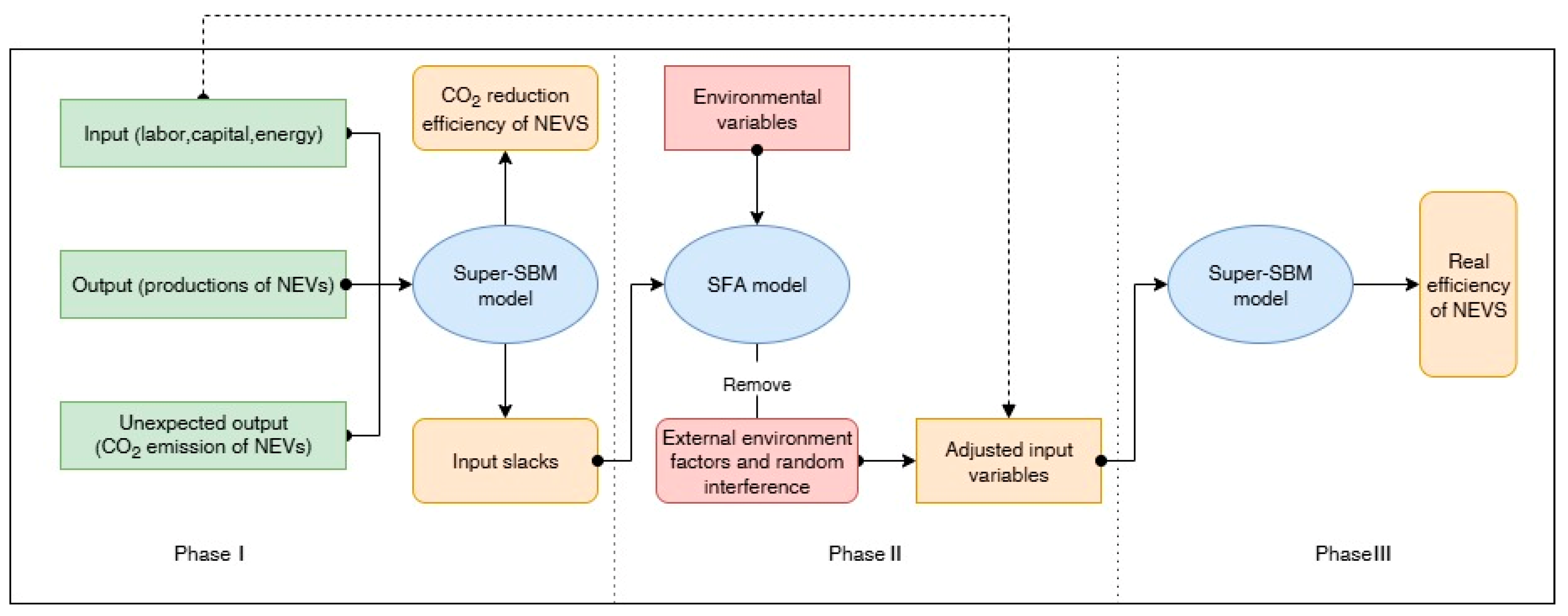
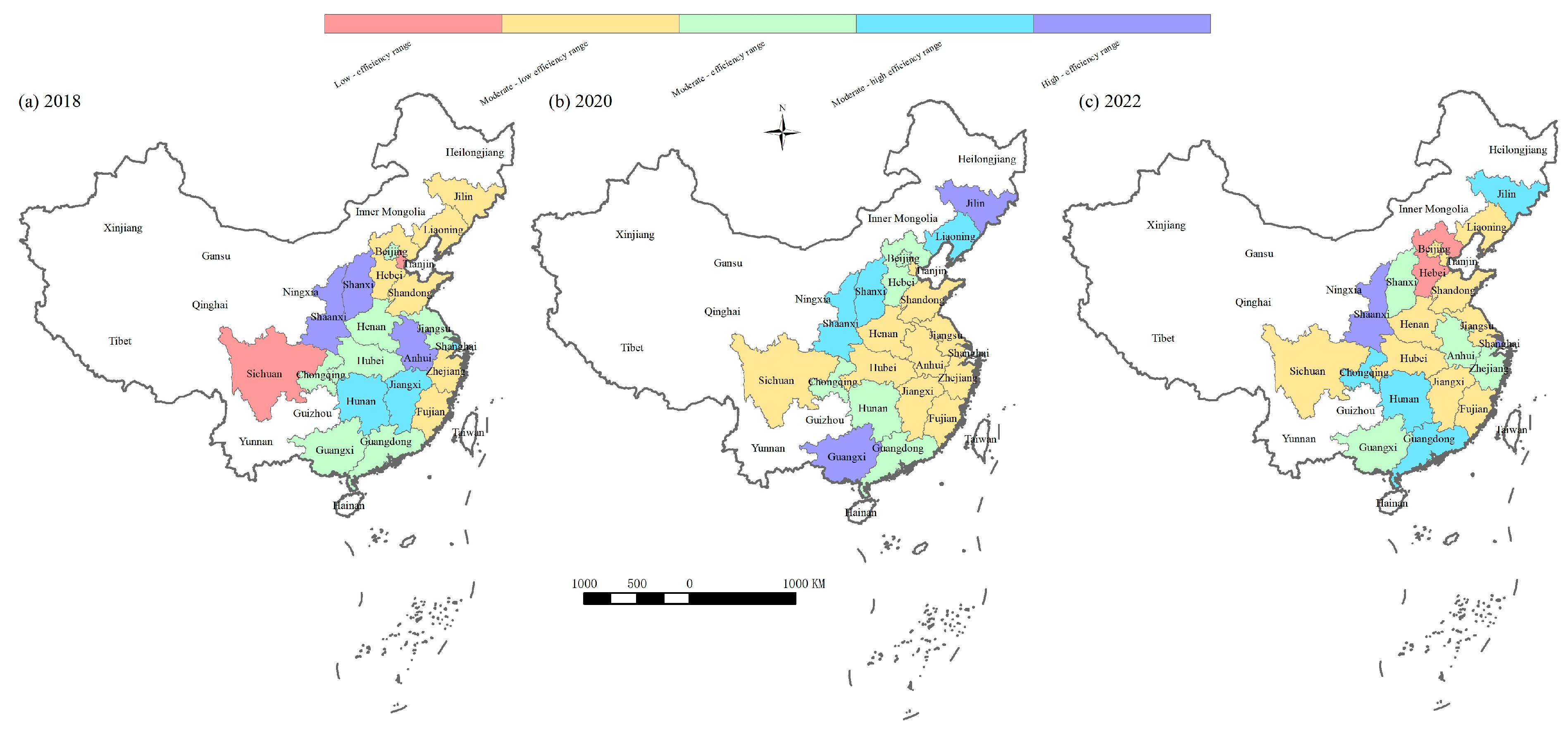
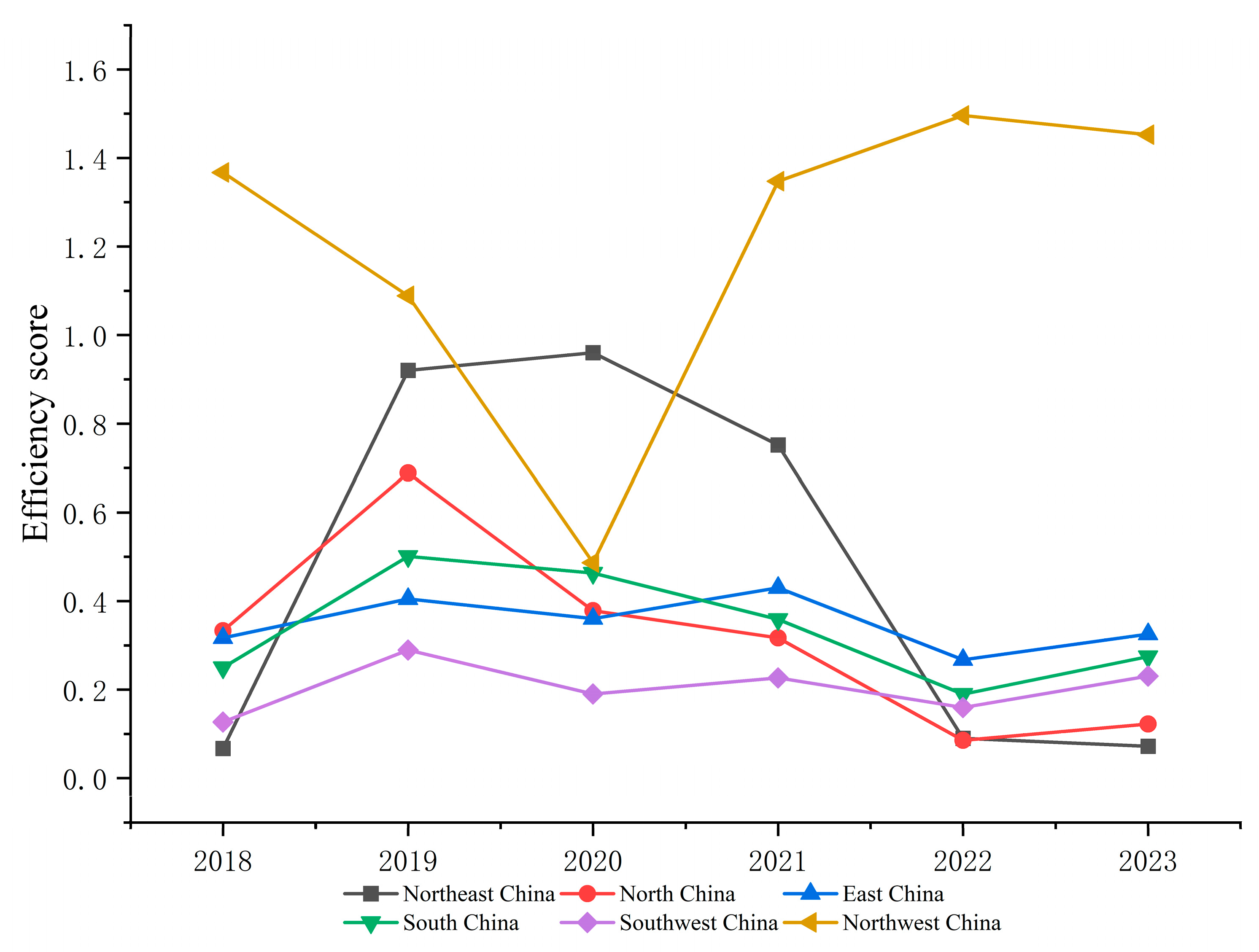
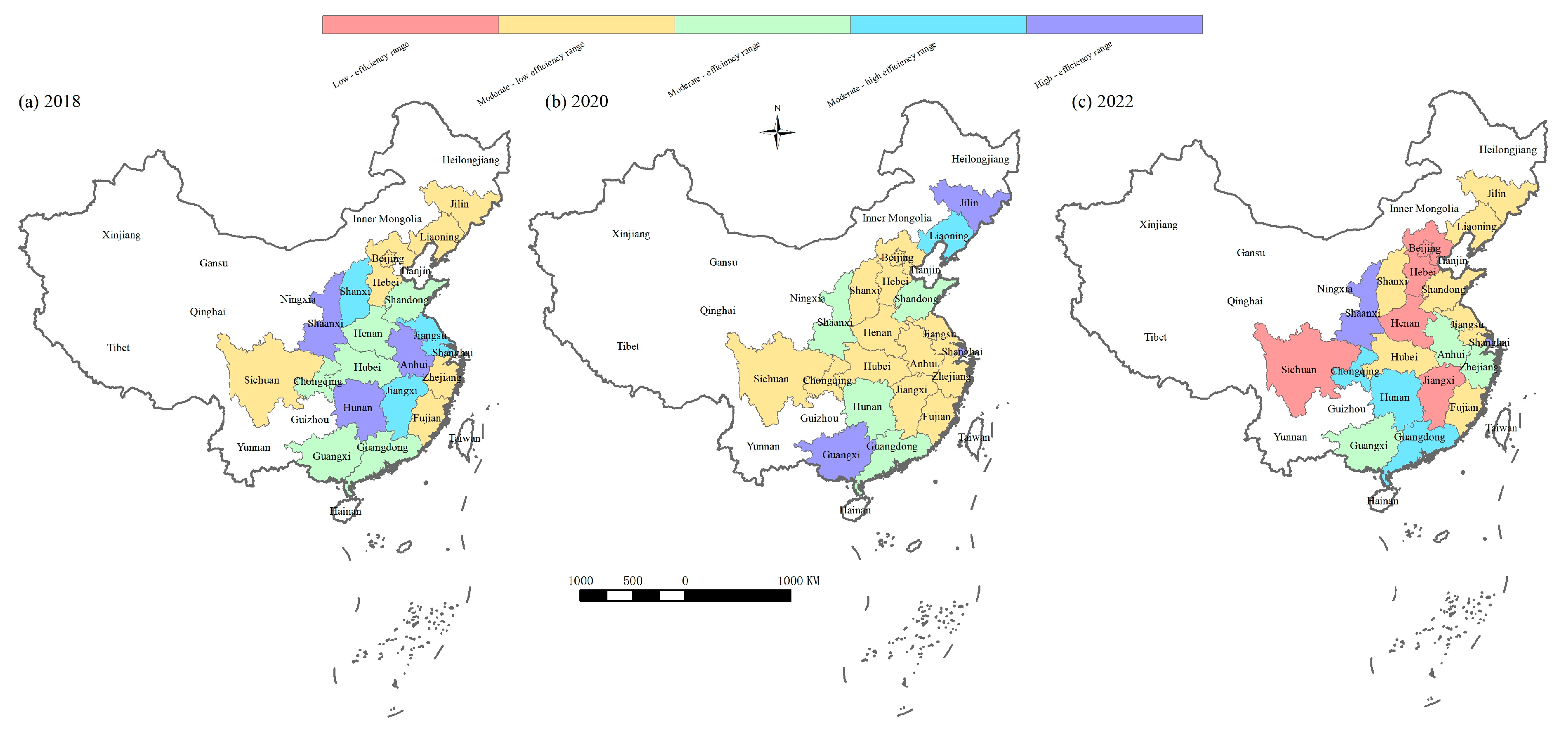
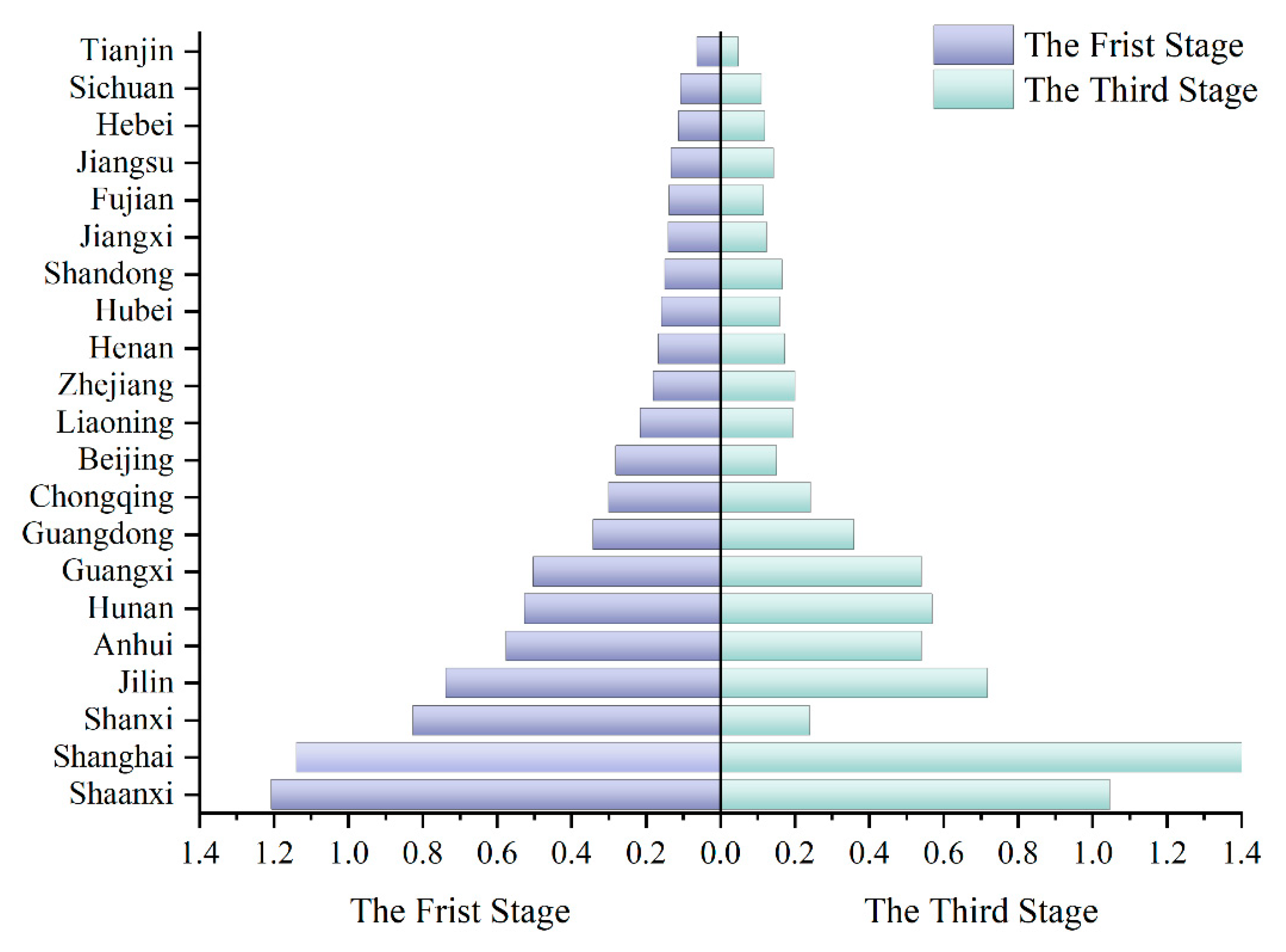
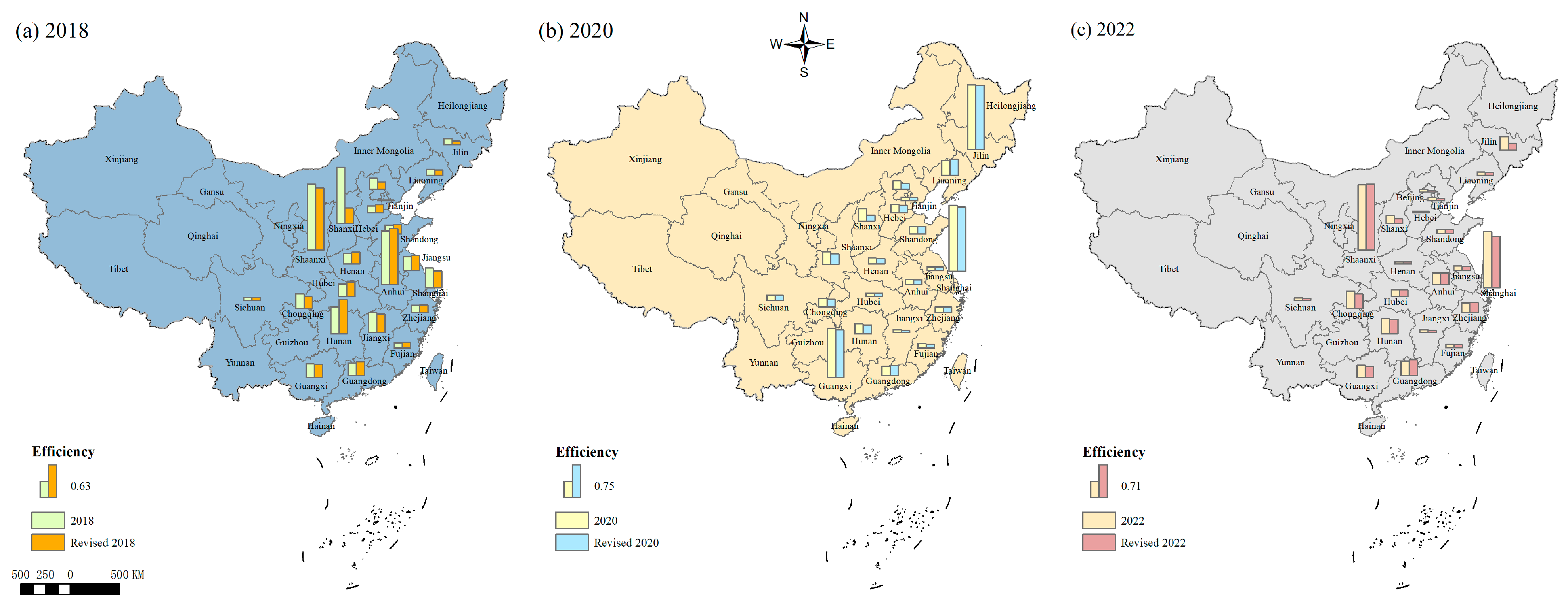
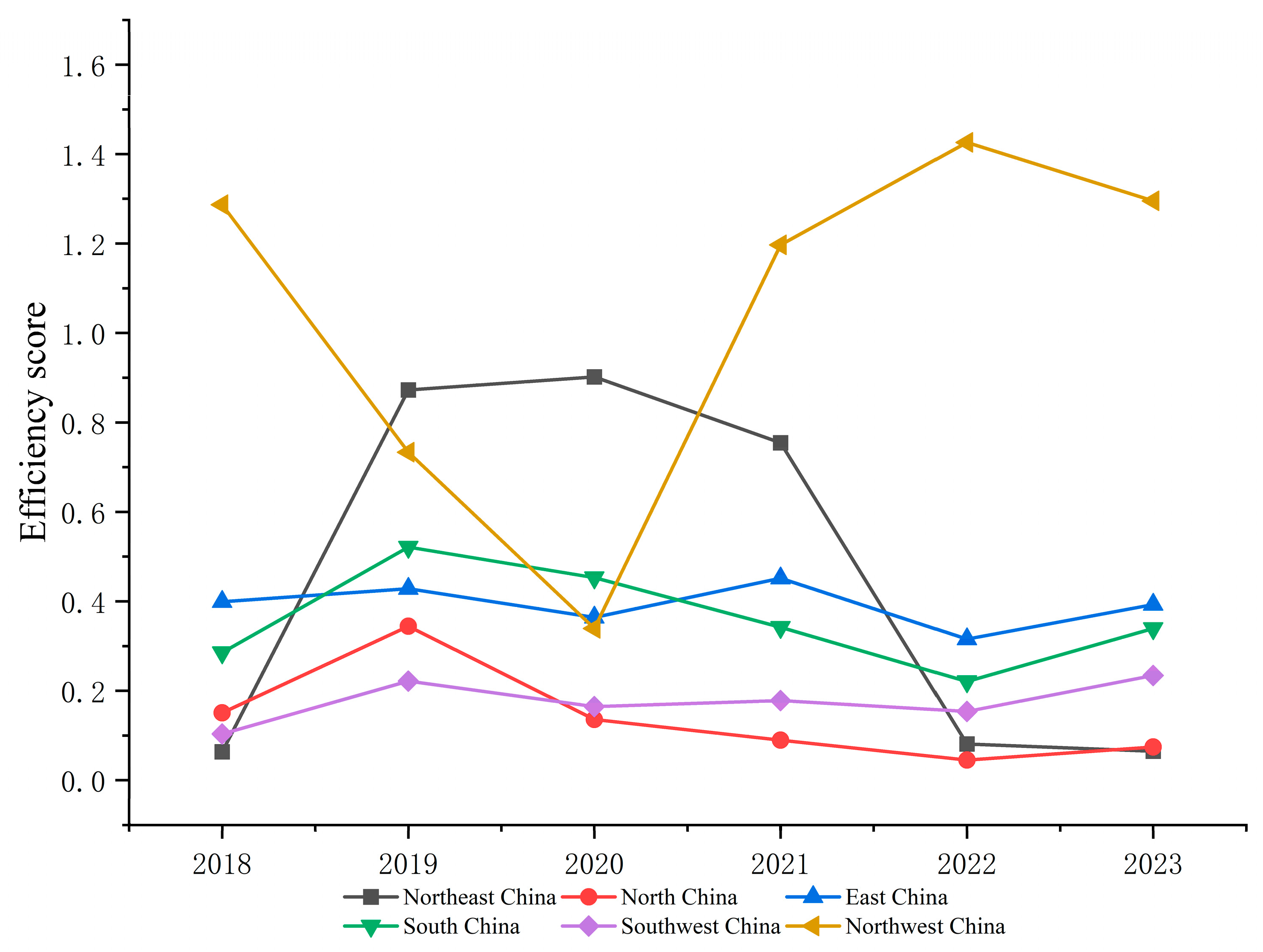
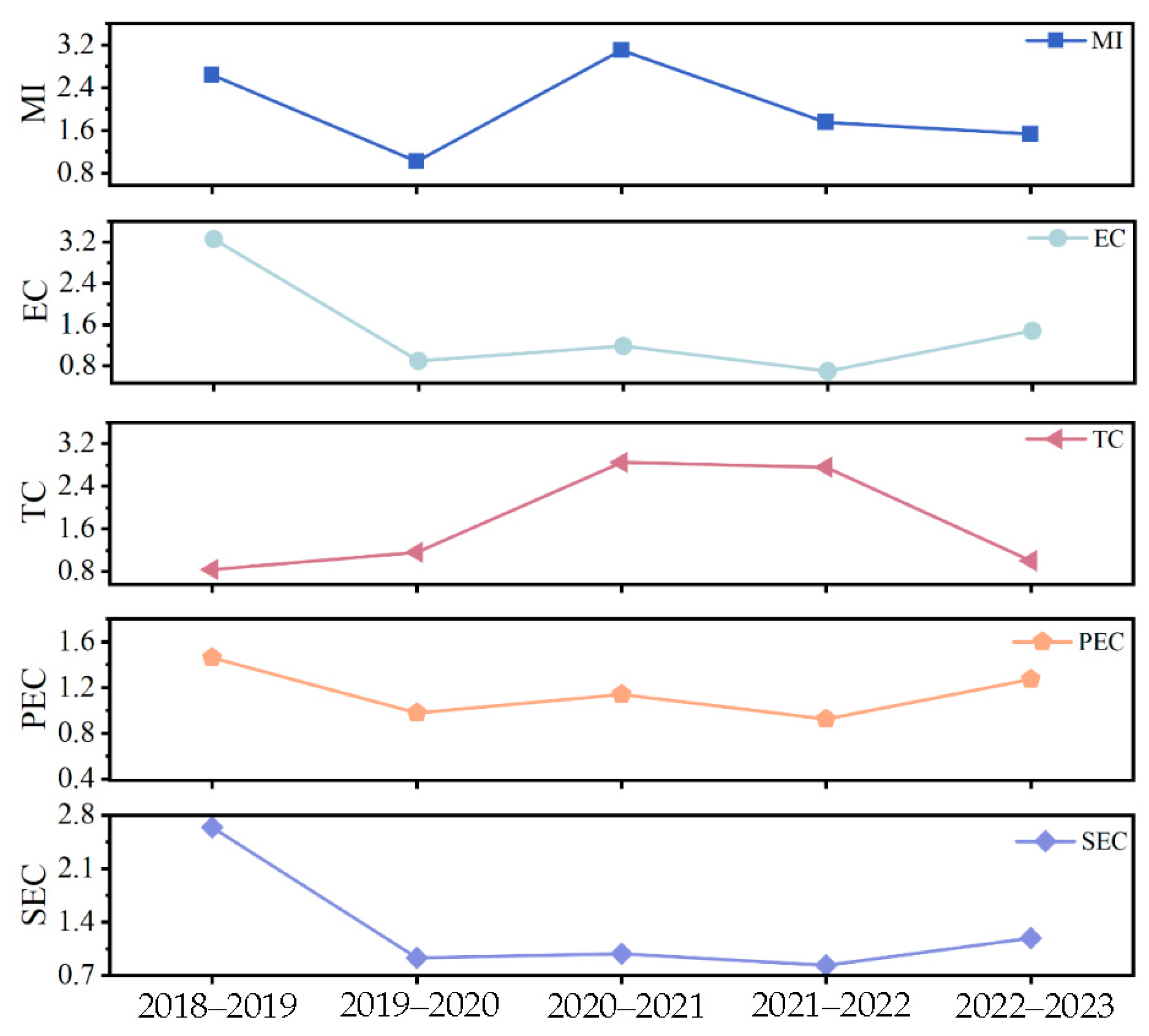
| Item | Norm | Factor Layer | Unit |
|---|---|---|---|
| Input indicators | Labor input | Number of laborers in the automotive manufacturing industry | Persons |
| Capital input | Fixed capital stock of the automotive industry | RMB million | |
| Energy consumption input | Total energy consumption in the automotive industry | Million tons of standard coal | |
| Output indicator | NEV production | NEV production | Unit |
| Non-expected output indicator | CO2 | CO2 emissions during the operation of NEVs | Tons |
| Environment variables | Urbanization level | Urbanization rate | % |
| Social consuming level | Consumption expenditure per inhabitant | RMB | |
| Technical level | Number of active patents | Pieces |
| Region | Average Annual Distance Traveled (km) |
|---|---|
| Northeast China | 12,404.47 |
| North China | 12,090.07 |
| East China | 12,222.88 |
| Central South China | 13,124.91 |
| Southwest China | 12,261.78 |
| Northwest China | 13,058.17 |
| Item | Norm | Max | Min | Average | S.D. |
|---|---|---|---|---|---|
| Inputs | Number of laborers in the automotive manufacturing industry | 435,600.00 | 12,818.00 | 143,869.24 | 95,762.02 |
| Fixed capital stock of the automotive industry | 4819.92 | 110.27 | 1556.85 | 1051.29 | |
| Total energy consumption in the automotive industry | 37,306.35 | 1608.71 | 12,334.08 | 7646.90 | |
| Desirable output | NEV production | 2,531,800.00 | 1500.00 | 200,908.94 | 328,761.95 |
| Undesirable output | CO2 emissions during the operation of NEVs | 3,425,558.38 | 13,390.53 | 421,860.60 | 501,227.34 |
| Environment variables | Urbanization rate | 89.30 | 50.22 | 66.85 | 10.15 |
| Consumption expenditure per inhabitant | 52,508.00 | 14,810.00 | 25,052.46 | 8500.32 | |
| Number of active patents | 665,600.00 | 4612.00 | 109,356.15 | 134,767.44 |
| DMU | 2018 | Rank | 2019 | Rank | 2020 | Rank | 2021 | Rank | 2022 | Rank | 2023 | Rank |
|---|---|---|---|---|---|---|---|---|---|---|---|---|
| Guangdong | 0.214 | 8 | 0.330 | 11 | 0.389 | 7 | 0.381 | 8 | 0.265 | 5 | 0.477 | 3 |
| Zhejiang | 0.118 | 15 | 0.249 | 13 | 0.199 | 13 | 0.185 | 12 | 0.170 | 9 | 0.166 | 9 |
| Shanghai | 0.272 | 6 | 1.004 | 7 | 1.504 | 1 | 1.548 | 1 | 1.194 | 2 | 1.312 | 2 |
| Jiangsu | 0.224 | 7 | 0.089 | 20 | 0.124 | 18 | 0.151 | 15 | 0.084 | 12 | 0.122 | 13 |
| Shandong | 0.139 | 14 | 0.160 | 17 | 0.234 | 9 | 0.194 | 11 | 0.073 | 14 | 0.095 | 15 |
| Henan | 0.191 | 10 | 0.320 | 12 | 0.219 | 11 | 0.163 | 14 | 0.052 | 16 | 0.057 | 20 |
| Beijing | 0.163 | 13 | 1.116 | 4 | 0.193 | 14 | 0.030 | 21 | 0.051 | 17 | 0.134 | 11 |
| Sichuan | 0.045 | 20 | 0.145 | 18 | 0.171 | 17 | 0.140 | 17 | 0.050 | 18 | 0.096 | 14 |
| Hebei | 0.093 | 17 | 0.175 | 15 | 0.226 | 10 | 0.109 | 18 | 0.026 | 21 | 0.051 | 21 |
| Guangxi | 0.190 | 11 | 0.483 | 9 | 1.266 | 3 | 0.564 | 5 | 0.199 | 8 | 0.317 | 7 |
| Anhui | 1.017 | 3 | 1.060 | 6 | 0.181 | 15 | 0.564 | 6 | 0.211 | 7 | 0.424 | 4 |
| Hubei | 0.181 | 12 | 0.226 | 14 | 0.109 | 19 | 0.180 | 13 | 0.109 | 11 | 0.145 | 10 |
| Tianjin | 0.008 | 21 | 0.056 | 21 | 0.093 | 21 | 0.055 | 20 | 0.041 | 20 | 0.126 | 12 |
| Hunan | 0.474 | 4 | 1.146 | 3 | 0.334 | 8 | 0.505 | 7 | 0.325 | 3 | 0.376 | 5 |
| Fujian | 0.111 | 16 | 0.106 | 19 | 0.179 | 16 | 0.274 | 10 | 0.079 | 13 | 0.078 | 18 |
| Shaanxi | 1.367 | 1 | 1.088 | 5 | 0.487 | 5 | 1.347 | 3 | 1.496 | 1 | 1.453 | 1 |
| Chongqing | 0.209 | 9 | 0.434 | 10 | 0.209 | 12 | 0.313 | 9 | 0.269 | 4 | 0.365 | 6 |
| Shanxi | 1.070 | 2 | 1.407 | 1 | 1.003 | 4 | 1.073 | 4 | 0.225 | 6 | 0.178 | 8 |
| Jiangxi | 0.336 | 5 | 0.167 | 16 | 0.103 | 20 | 0.092 | 19 | 0.060 | 15 | 0.083 | 16 |
| Liaoning | 0.070 | 18 | 0.516 | 8 | 0.445 | 6 | 0.148 | 16 | 0.050 | 19 | 0.065 | 19 |
| Jilin | 0.064 | 19 | 1.324 | 2 | 1.476 | 2 | 1.355 | 2 | 0.130 | 10 | 0.079 | 17 |
| Mean | 0.312 | — | 0.553 | ↑ | 0.435 | ↓ | 0.446 | ↑ | 0.246 | ↓ | 0.295 | ↑ |
| Environmental Variables | Dependent Variables | |||||
|---|---|---|---|---|---|---|
| Slack of Labor | (t) | Slack of Capital | (t) | Slack of Energy | (t) | |
| Constant | −71,144.15 | −6745.10 *** | −1116.74 | −4.2 *** | −25,783.44 | −19.41 *** |
| Urbanization | −3150.93 | −4.33 *** | −1745.66 | −5.33 *** | 934.73 | 3.28 *** |
| Consumption level | 3.94 | 1.86 ** | 736.98 | 1.98 ** | 11,408.62 | 16.66 *** |
| technical level | −0.18 | −3.73 *** | −2622.15 | −5.54 *** | −7909.93 | −4.63 *** |
| σ2 | 9.49 × 109 | 9.49 × 109 *** | 1.29 × 106 | 3.36 × 105 *** | 1.21 × 108 | 1.19 × 108 ** |
| γ | 0.84 | 36.51 *** | 0.82 | 31.74 *** | 0.93 | 131.23 *** |
| Log-likelihood function | −1547.74 | −1067.01 | −1239.40 | |||
| LR | 71.83 | 119.63 | 121.94 | |||
| DMU | 2018 | Rank | 2019 | Rank | 2020 | Rank | 2021 | Rank | 2022 | Rank | 2023 | Rank |
|---|---|---|---|---|---|---|---|---|---|---|---|---|
| Guangdong | 0.246 | 8 | 0.345 | 10 | 0.343 | 5 | 0.302 | 7 | 0.318 | 4 | 0.603 | 3 |
| Zhejiang | 0.148 | 14 | 0.290 | 13 | 0.186 | 11 | 0.166 | 12 | 0.210 | 8 | 0.203 | 8 |
| Shanghai | 1.095 | 2 | 1.187 | 3 | 1.612 | 1 | 1.747 | 1 | 1.442 | 1 | 1.637 | 1 |
| Jiangsu | 0.276 | 7 | 0.094 | 19 | 0.120 | 17 | 0.128 | 16 | 0.098 | 11 | 0.142 | 10 |
| Shandong | 0.176 | 12 | 0.175 | 16 | 0.246 | 8 | 0.208 | 10 | 0.083 | 13 | 0.107 | 12 |
| Henan | 0.232 | 9 | 0.332 | 11 | 0.208 | 10 | 0.144 | 15 | 0.058 | 15 | 0.064 | 19 |
| Beijing | 0.133 | 15 | 0.565 | 7 | 0.115 | 18 | 0.016 | 21 | 0.025 | 21 | 0.056 | 21 |
| Sichuan | 0.052 | 19 | 0.149 | 17 | 0.165 | 13 | 0.124 | 17 | 0.054 | 17 | 0.115 | 11 |
| Hebei | 0.115 | 16 | 0.185 | 15 | 0.216 | 9 | 0.111 | 18 | 0.030 | 20 | 0.060 | 20 |
| Guangxi | 0.212 | 10 | 0.498 | 8 | 1.319 | 3 | 0.613 | 5 | 0.225 | 7 | 0.373 | 6 |
| Anhui | 0.668 | 3 | 1.022 | 4 | 0.168 | 12 | 0.642 | 4 | 0.241 | 6 | 0.503 | 4 |
| Hubei | 0.193 | 11 | 0.223 | 14 | 0.094 | 19 | 0.151 | 14 | 0.124 | 9 | 0.168 | 9 |
| Tianjin | 0.007 | 21 | 0.047 | 21 | 0.061 | 21 | 0.035 | 20 | 0.036 | 19 | 0.106 | 13 |
| Hunan | 0.543 | 4 | 1.208 | 2 | 0.301 | 7 | 0.499 | 6 | 0.378 | 3 | 0.487 | 5 |
| Fujian | 0.106 | 17 | 0.089 | 20 | 0.135 | 16 | 0.210 | 9 | 0.078 | 14 | 0.077 | 15 |
| Shaanxi | 1.287 | 1 | 0.733 | 5 | 0.339 | 6 | 1.197 | 3 | 1.426 | 2 | 1.295 | 2 |
| Chongqing | 0.155 | 13 | 0.295 | 12 | 0.164 | 14 | 0.232 | 8 | 0.253 | 5 | 0.354 | 7 |
| Shanxi | 0.348 | 5 | 0.580 | 6 | 0.152 | 15 | 0.195 | 11 | 0.089 | 12 | 0.076 | 16 |
| Jiangxi | 0.323 | 6 | 0.140 | 18 | 0.081 | 20 | 0.062 | 19 | 0.056 | 16 | 0.081 | 14 |
| Liaoning | 0.079 | 18 | 0.447 | 9 | 0.371 | 4 | 0.154 | 13 | 0.051 | 18 | 0.065 | 17 |
| Jilin | 0.048 | 20 | 1.298 | 1 | 1.432 | 2 | 1.355 | 2 | 0.111 | 10 | 0.065 | 18 |
| Mean | 0.307 | — | 0.472 | ↑ | 0.373 | ↓ | 0.395 | ↑ | 0.257 | ↓ | 0.316 | ↑ |
Disclaimer/Publisher’s Note: The statements, opinions and data contained in all publications are solely those of the individual author(s) and contributor(s) and not of MDPI and/or the editor(s). MDPI and/or the editor(s) disclaim responsibility for any injury to people or property resulting from any ideas, methods, instructions or products referred to in the content. |
© 2025 by the authors. Licensee MDPI, Basel, Switzerland. This article is an open access article distributed under the terms and conditions of the Creative Commons Attribution (CC BY) license (https://creativecommons.org/licenses/by/4.0/).
Share and Cite
Zheng, L.; Zhan, F.; Ren, F. Carbon Dioxide Emission-Reduction Efficiency in China’s New Energy Vehicle Sector Toward Sustainable Development: Evidence from a Three-Stage Super-Slacks Based-Measure Data Envelopment Analysis Model. Sustainability 2025, 17, 7440. https://doi.org/10.3390/su17167440
Zheng L, Zhan F, Ren F. Carbon Dioxide Emission-Reduction Efficiency in China’s New Energy Vehicle Sector Toward Sustainable Development: Evidence from a Three-Stage Super-Slacks Based-Measure Data Envelopment Analysis Model. Sustainability. 2025; 17(16):7440. https://doi.org/10.3390/su17167440
Chicago/Turabian StyleZheng, Liying, Fangjuan Zhan, and Fangrong Ren. 2025. "Carbon Dioxide Emission-Reduction Efficiency in China’s New Energy Vehicle Sector Toward Sustainable Development: Evidence from a Three-Stage Super-Slacks Based-Measure Data Envelopment Analysis Model" Sustainability 17, no. 16: 7440. https://doi.org/10.3390/su17167440
APA StyleZheng, L., Zhan, F., & Ren, F. (2025). Carbon Dioxide Emission-Reduction Efficiency in China’s New Energy Vehicle Sector Toward Sustainable Development: Evidence from a Three-Stage Super-Slacks Based-Measure Data Envelopment Analysis Model. Sustainability, 17(16), 7440. https://doi.org/10.3390/su17167440






